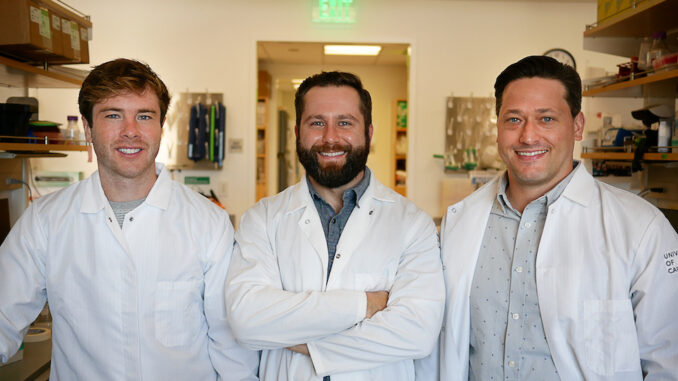
Benjamin Rubin was a post-doc in the lab of Jennifer Doudna—a Nobel-prize-winning scientist who pioneered CRISPR-Cas9—when a colleague got him thinking about a microbial ecology problem. He started to wonder: could it be possible to change the DNA of microorganisms without first isolating them in the laboratory? Since microorganisms often behaved very differently in isolation versus in a community, a method for editing the genes of microorganisms without removing them from their community context could create a whole new path for understanding microbial gene functions.
Rubin and Doudna came up with the idea of a ‘screening’ tool that would pinpoint what DNA within a microbial community was editable. Then, Rubin remembers talking with a newer lab member, Brady Cress, while they were floating down California’s Russian River on inner tubes during a lab group retreat. All the way down the river, the two discussed state-of-the-art genome editing tools and mused on whether any of them would work for microbial community editing purposes.
Later, as the idea started to crystallize, they brought in Spencer Diamond, a microbiologist from Banfield lab who had also been thinking about how to affect change in intact microbial communities. Diamond came with the expertise to lead development of the software packages and informatic methodologies for the project.
The trio’s work led to a recent publication in Nature Microbiology that demonstrated, for the first time, a strategy for editing the genomes of specific organisms within microbial communities. The paper described a two-part technique. First, the group used environmental transformation sequencing (ET-seq, pronounced “E T seek”), in which nontargeted transposon insertions were delivered to a microbial community, then tracked to find out which constituents of the community were manipulable. Next, in the organisms that showed potential for genetic manipulation, they applied all-in-one RNA-guided CRISPR–Cas transposase (DART) systems to insert DNA. Together, ET-seq and DART allowed the group to successfully manipulate the genes of individual members of a microbial community, without the need for culturing.
In an interview with Microbiome Times, Rubin, Cress, and Diamond emphasized that getting these systems to work for microbial community editing was not an easy task.
Rubin says,
“On the ET-SEQ front, looking for genetic accessibility in these communities was a slow process of coaxing the signal out of the noise.”
As for the development of DART, Cress says the group tested several existing gene editing techniques to see which one was suitable for their purposes. Although several techniques proved inefficient, he says,
“It was clear immediately that [Cas-guided transposon systems] are awesome. They work really well.”
Rubin adds,
“Our DART method was based on previous systems, but Brady put them together in this new all-in-one format, delivered by conjugation—a different delivery approach. When we used DART in E. coli for the first time, we measured thousands of insertions, and every single one of them was on target. And using it in communities since then, there have been very few off-target. It is amazing that these systems can search through millions of base pairs across many different organisms, and still only insert at that targeted location.”
For Cress, the exciting part came when they saw the success of the technique in non-model organisms such as wild Pseudomonas.
“That was the point where I [realized we could use DART for all kinds of bacteria and I wanted] to get the tool into every non-model organism [possible].”
Part of the process was also to discover the limits of these tools in complex microbial communities.
“If you try to do a conjugation to a random community, you’ll be lucky to get one or two organisms transformed,”
says Diamond, noting that some components may need to be optimized in a community-specific way.
“When we were seeing one or two organisms get transformed in a human microbiome enrichment, at first it was disappointing. But the flip side is, it’s actually pretty interesting to understand that it’s the norm.”
The biggest breakthrough this brings to the microbiome field is the ability researchers now have to interrogate the functions of microbial genes without having to remove them from their community context. Diamond says,
“Ninety-nine percent of microbes have never been cultivated, and probably a very large fraction of those cannot be cultivated using any current method that we know. Then, probably a large fraction of those are dependent on other microbes. We need methods to be able to interrogate gene function in mixed microbial systems. It’s just critical.”
Rubin uses the analogy of a school for how discovery of microbial gene function has proceeded to date. He says,
“What we’ve been doing is pulling people out of a school and observing them individually, and trying to interpret how that school functions based on that. You’ll probably never really understand the interactions that happen at a school that way.”
Their new system, on the other hand, is similar to observing and testing students in the ‘real life’ context of the complex school environment.
Using the technique to add DNA to microbes at a suitable efficiency is still a challenge. Rubin says the group is currently working on ways to bring about greater penetrance of the initial mutation, and as demonstrated in the paper, ways to make an edit at low efficiency and enrich for it.
But Cress says,
“Even with low editing efficiency and even without selection, depending on the circumstances, we can break genes. It might be a gene [with an unknown] function, and we can learn something about its fitness directly within a community. That’s a really powerful approach.”
The three were careful to emphasize that, in the short term, the new system is useful primarily for research purposes. As with any new technology, they say the research should proceed step-by-step so its true potential and limitations have a chance to emerge.
Rubin says that over the longer term, he hopes the technology will be used to modify environmental- or health-relevant communities, to function in ways that improve human health or the global ecosystem.
“I would be astounded if in 20 years, people are not making DNA edits to microbial communities—definitely for basic research, and probably also for human disease, for industrial processes,” he says. “This is one of the very first forays into a new field. We’ve taken a very small step and we hope that other people will take lots of further steps.”


